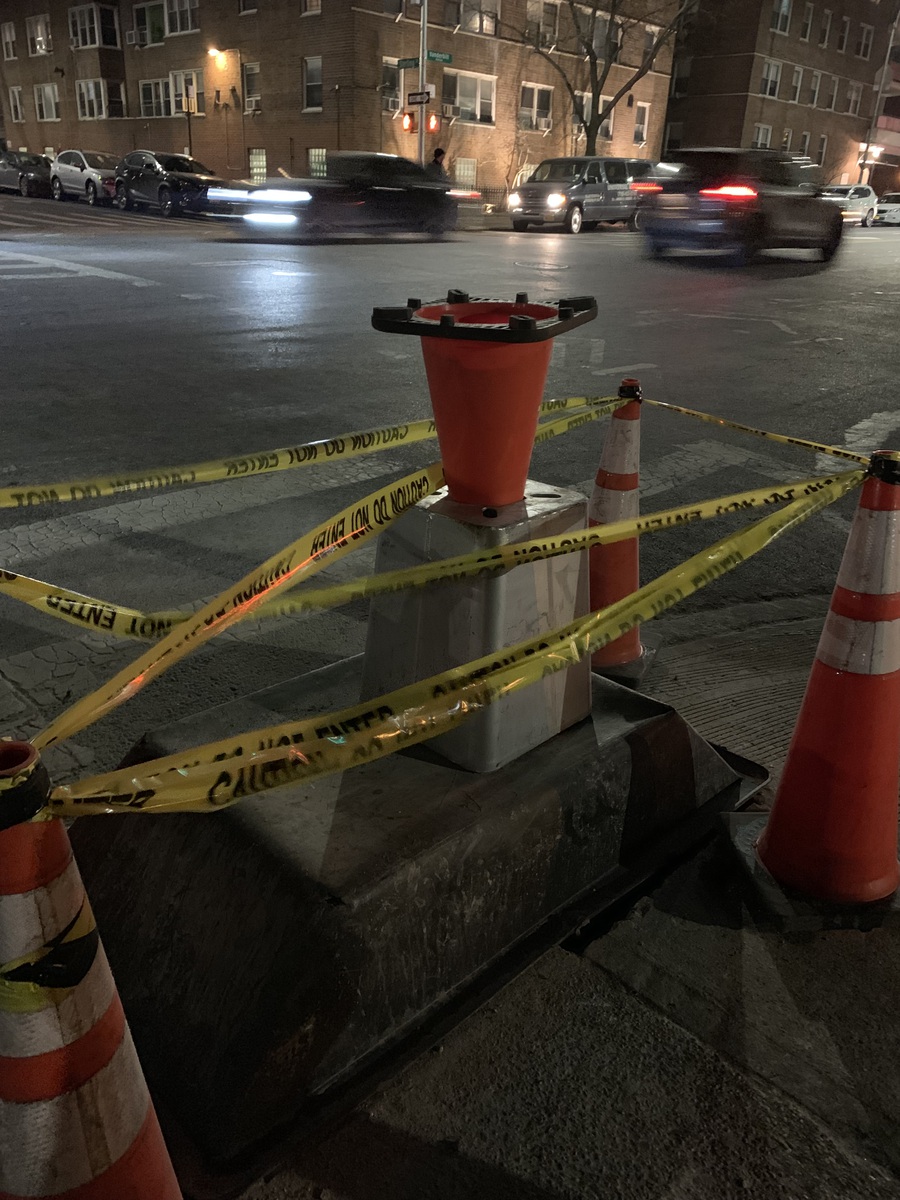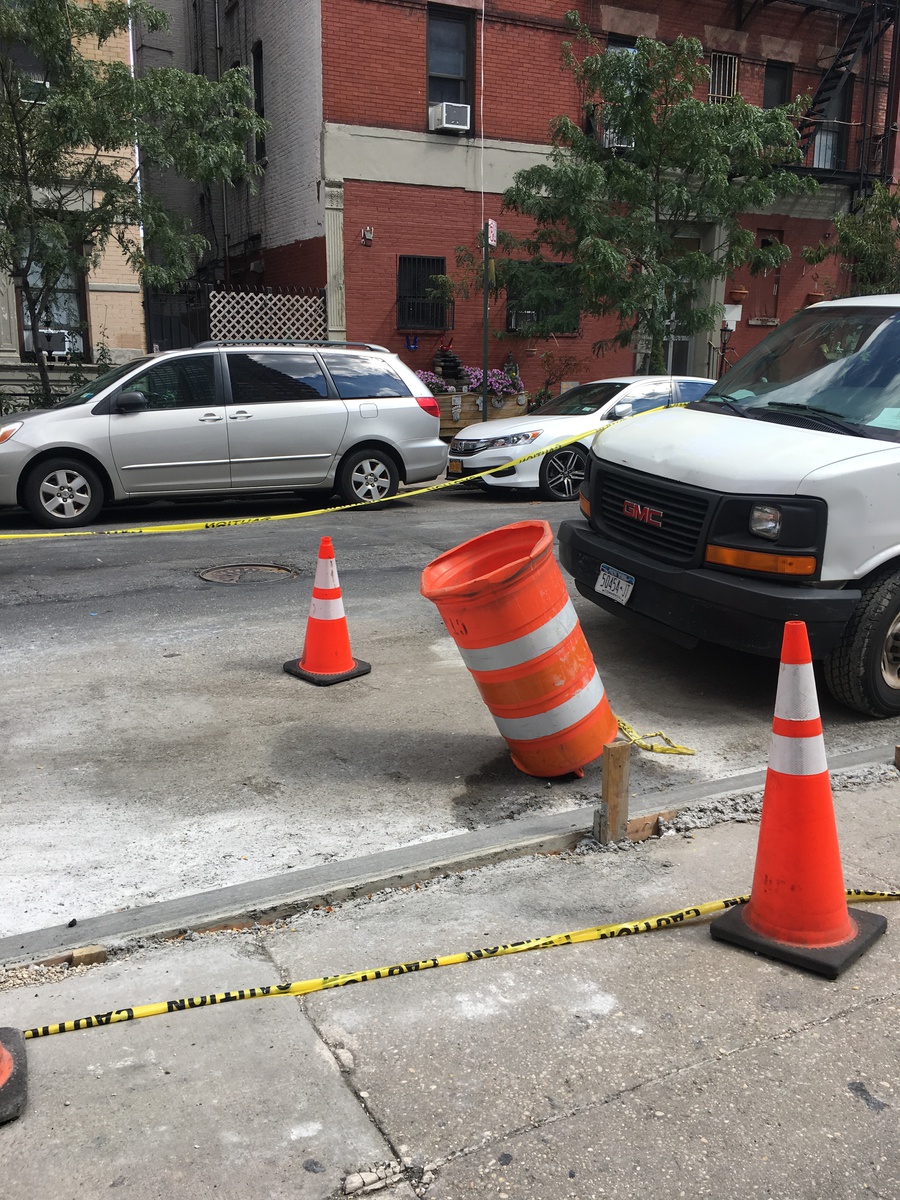

Safety cones have a nearly ritualistic purpose in New York City, presumably a function of habit, local custom, and the “law of large numbers” that dominates life in a dense urban area. The streets, buildings, utility vaults, sidewalks, and so on are also quite old in U.S. terms (though laughably young compared to infrastructure in other parts of the world), and the delightful utility and communications privatization of the 80s means every strip of roadway, block of sidewalk, hand-hole, and storm garden is at near-constant risk of being dug in search of whatever lies beneath.2 3
In particular, the city is long on concerned citizens and relatively short on trained specialists. The trained specialists (lineworkers, telecom crews, road crews, and many others that keep the city breathing, humming, and buzzing) that do interact with the environment tend to be wanting of time and equipment, and so often leave the jobsite in what begins as a temporary state, but quickly becomes long-term. Building superintendents, frustrated brownstone owners, traffic enforcement agents, and others set to work, making do with found objects and doing their best to make sure their little stretch of sidewalk is safe.4
The object most often close-at-hand? The humble traffic cone.
While not exactly cheap, they have the advantage of being mostly unaccountable—a few have the owning company’s logo screenprinted on them, but more often than not, they’re anonymous, ubiquitous, and won’t be missed. Without serial numbers or an RFID tag, and with personal injury attorneys ever looming5, you can’t really get yelled at for using (or losing) too many cones.
So then: a tour of cones and their usage in New York City.

Here, a cone is doing double duty—it’s providing a visible warning of a possible trip hazard, and it’s preventing wandering hands from touching the (possibly live) wiring inside the street lamp base until the concrete sets and the lamp post can be installed.
(This is on the same block as the locally-famous digital construction sign “hack,” shown below, and it’s with some irony I report the original streetlight was destroyed by—you guessed it—a speeding vehicle.)
What makes this traffic barrel more effective upside-down rather than right-side up? Only the person who placed it knows. It might be covering some exposed rebar in lieu of a proper impalement cap.

Cones can also be used to simultaneously mark and fill a pothole. By inserting the cone into the opening, passers-by are discouraged from moving the cone to find out what’s underneath, and the cone won’t migrate in heavy wind.

In the most extreme case, the cone has completely transcended its
function as a highly visible warning indicator, subsumed instead by the
role of sealing and filling: 
If a hole is too large for a single cone to fill, multiple cones can
be used.  As in earlier examples, these cones are serving both as a warning to
drivers and pedestrians—look out! pothole!—but also as a temporary fix.
Based on the tire marks, it appears these cones have successfully
functioned as roadway themselves.
As in earlier examples, these cones are serving both as a warning to
drivers and pedestrians—look out! pothole!—but also as a temporary fix.
Based on the tire marks, it appears these cones have successfully
functioned as roadway themselves.
Note, too, that there are three distinct types of cone present in this photo: a harder-plastic type with an indentation for use with a linking cone bar, the older, more rubber-type cone, and a thinner, cylindrical one, sometimes called a “delineator” cone and typically used for lane markings. Were these cones re-purposed from other nearby hazards in order to address this more pressing pothole? Were these the oldest or most damaged cones available to the individual that marked this hole? Or were the cones added one at a time as the pothole grew as rain and traffic chipped at the edges?
Is it any coincidence that Con Edison’s current wordmark, stylized coned, spells “coned?”
Saving parking doesn’t work
It’s impossible to pinpoint a precise number of traffic cones that are stolen. Utilities say they allow their employees to repossess traffic cones, though not if they are being used in a safety function. Current owners do not take kindly to having their cones touched. John DiGiulio, a Water Department spokesman, said he collects them only if he is in an official vehicle so there is no misunderstanding.
Blew, the PSE&G manager, said the company doesn’t worry much about the strays.
“We do a lot of community involvement,” he said. “If I was to be out somewhere at a function in a local township, and they have some PSE&G cones, I wouldn’t go over there and say, ‘Hey, give me those cones back.’ They’re out there, they’re doing good work as a cone, and we don’t really police that.”
https://www.inquirer.com/business/where-do-all-the-stolen-traffic-cones-go-20190519.html
Ingrid Burrington, Networks of New York: an Illustrated Field Guide to Urban Internet Infrastructure (Brooklyn: Melville House, 2016).↩︎
The NYC DOT has come up with a fairly reasonable scheme where utilities are encouraged to do maintenance just before resurfacing, and thereafter, the fresher the road surface you are digging up, the more of a fine you pay. This, of course, does not apply to gardens.↩︎
For good reason. The responsibilities—and liability—of building owners with sidewalk frontage are significant.↩︎
https://nymag.com/intelligencer/article/cellino-and-barnes-breakup.html↩︎